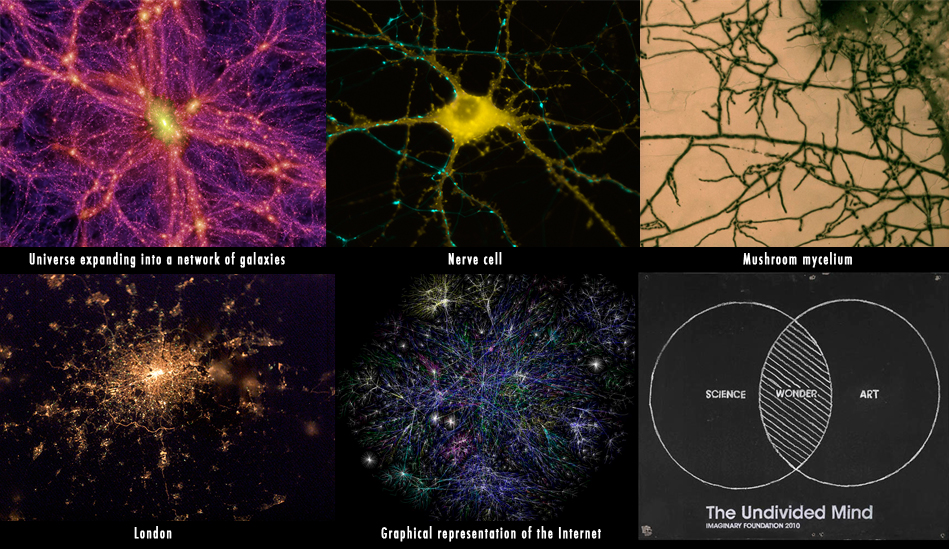‘We Are As Gods’ Explores the Legacy of Stewart Brand and the Critical Importance of Culture

Earlier this month, Big Think sat down with filmmaker Jason Sussberg of Structure Films to discuss We Are As Gods, a new documentary produced by Jason and fellow filmmaker David Alvarado about the life and legacy of the American writer Stewart Brand. The film is a beautiful look at the life of this cultural icon and his controversial legacy. The film is now available to stream on Amazon Prime and iTunes.
This interview has been edited for length and clarity.
Big Think: So how did this film come about? Why this project? Why this subject?
Jason Sussberg: There are so many origin stories. It’s hard to keep track of because there’s no one particular aha moment. It’s a lot of little things that led to us doing this. [David and I] started in 2010 working on The Immortalists and on Bill Nye: Science Guy in 2014.
I was thinking about this on the way over here. The very first time I interacted with [Stewart and The Whole Earth Catalog], I was in college and I was at a bookstore and I saw The Whole Earth Catalog. And that was like 30 years after it was published. I picked it up and I was like, “Wow, this is what the past thought the future could be from some hippie ideal,” but it wasn’t just organic farming and tilling the land. It was actually geodesic domes and solar water heaters and all this cool technology.
And in 2013, I heard Stewart talk about the de-extinction conference. I remember being like, “I cannot believe this guy who is the prince of the hippies wants to bring back a passenger pigeon. That’s so cool”. And so at that point, David and I convinced TIME Magazine to let us go and talk to Stewart and do a video. And in the back of my mind, I was like, “Oh cool. This is kind of kicking the front door open and holding her foot there.” And hey, we’re here.
Big Think: Stewart really has had an incredible career and a profound impact on a lot of people. And this comes up in the film—the idea that he’s some sort of a Forrest Gump figure. Always showing up at just the right time at all these incredibly important inflection points in modern history.
Sussberg: Yeah, it’s funny. That was one of the things that kept on popping up was like, everybody had their own way of talking about it. That’s why it made for a fun intro. It’s like Johnny Appleseed, Forrest Gump, Barnum & Bailey, whatever.
Big Think: Can we walk through some of those scenes where he appears? First, maybe you have the Merry Pranksters, which sort of became the birth of the modern hippie movement in many ways. Can you talk about that?
Sussberg: Well, in a way, Stewart—he just elevated the Merry Pranksters. Ken Kesey would have still been Ken Kesey. The Merry Pranksters would have still been the Merry Pranksters. And in a way, Stewart was kind of a little “Johnny-come-lately,” I guess. Kesey didn’t need Stewart. But I think what Stewart did was he elevated it.
And Stewart was a square. Tom Wolfe said he represented the square wing of the counterculture coming out of his background at his prep school and with the military. And so he was able to organize it. So I think without him there wouldn’t have been—definitely wouldn’t have been a Trips Festival. That was 100% Stewart. You could argue that Haight-Ashbury would have probably existed; Summer of Love would have probably existed. But it just wouldn’t have had that iconic moment. And perhaps it would have gotten skipped over. It’s impossible to know, but you kind of have to wonder: Had Stewart not been a Merry Prankster, would that scene have been elevated to the mainstream?
Big Think: And drugs obviously seem to play a big role, sort of a common thread through all of this. I’m curious what you make of that?
Sussberg: Yeah, totally. Stewart looked at drugs as a technology, the same way that you would look at personal computers like a technology. I mean, we don’t say this out loud in the movie, but we saw when we were piecing the movie together that Stewart was trying to shift our perspective on everything. In the case of drugs, it was shifting our perspective of mind and culture. You could hack culture with drugs. And then later on, he hacks the environment through the photograph of the whole Earth, which is another technology, photography, satellites, and space. And then he shifts our perspective with computers. And then later on with the clock, he shifts our perspective. And with de-extinction. They are really using the mammoth as an icon to shift our perspective about engineering life.
So drugs were really the beginning of recognizing that you could use a tool, a technology, to actually shift our perspective and change this intolerable milquetoast monoculture and turn it on to something really cool. And all you do is take this tiny little piece of technology and it’ll, like, vaporize all your preexisting notions and let you do new stuff. So that’s how we saw it.
And Stewart actually didn’t take drugs after that or after this, the last drug trip we had was in ’69—
Big Think: Really?
Sussberg:—so yeah, he was 31 when he did his last trip, but it’s kind of amazing that that has reverberations well after the trips were gone.
Stewart looked at drugs as a technology, the same way that you would look at personal computers like a technology. A tool to actually shift our perspective and change this intolerable milquetoast monoculture and turn it on to something really cool.
Big Think: To me, one of the fascinating throughlines throughout all those anecdotes really is not only Stewart’s ability to seemingly be in all the right places at the right time but his incredible knack for marketing and community. How do we capture people’s imaginations and create sort of a community? And from the photo to the catalog that’s really what he was doing. And it feels as if that community building really became the platform on which a lot of interesting people and ideas and movements emerged.
Sussberg: Well, George Church made some crack on camera that we never put in the movie. He said it’s funny that his last name is Brand because Stewart has a knack for branding. There’s no bigger icon than a dayglow bus driving across America. That’s an icon. The whole Earth image is an icon. Nowadays we call them memes and Stewart was an early meme-ologist, choosing these symbols and signals to blast out.
And they’re not complicated. They’re just not. A clock that will last 10,000 years. A mammoth. The whole Earth photo. These are simple icons. People are simple. And so he did a really good job at it. And Stewart’s dad actually worked in advertising. So I think that probably that had an effect rubbed off on him. Probably should have put that in the movie. [Laughs]

Big Think: So from there, it’s the rise of the environmental movement and Stewart begins to push the idea that we need something to rally the public consciousness and that a photo could do that.
Sussberg: Yeah, I mean he really tapped into something, because people didn’t have a way of thinking about this thing. From Rachel Carson’s writing to Thoreau and Emerson—all those early environmentalists didn’t have an icon.
They talked about Walden’s Pond, or Muir would go walk in the woods and talk about glacial activity. But it’s grounded in everybody’s personal relationship with the environment. This is my pond. This is my redwood tree. This is how I visualize this world.
But a universal icon—the whole world. I mean it still kind of gives me chills when I think about it. When we look at how fractured and balkanized everyone is, for everyone to have an icon that we all can be like, “Hey, that’s my flag. That’s our icon.” That’s pretty cool.
The whole earth image is an icon. Nowadays we call them memes and Stewart was an early meme-ologist choosing these symbols and signals to blast out.
Big Think: And do you know how that came about? Was this idea of the overview effect that astronauts describe already in the public consciousness? And then he just decided, “Well, why can’t we all have a version of that?” Or did he arrive at that separately? Do you have a sense of where this notion comes from?
Sussberg: It’s funny. We talked to Rusty Schweickart who was an Apollo 9 astronaut. He was one of the first guys, might even be the first, to do his space walk. And he talks eloquently about that overview effect and wrote this book or a book of, I think it was more of a story, really poetic about his experience of what became the overview effect. And later on, they became Stewart and Rusty became fast friends.
What Rusty asserted in an interview that we did with him is that Stewart was basically offering the whole world a microdose of the overview effect. My words, not his. But what Rusty says was that Stewart came up with a small slice of that for everyone.
Big Think: And obviously that photo then leads to the Whole Earth Catalog and his work there. And that becomes this real platform for ideas and discussion and helps inspire (along with his work with the Homebrew Computer Club) what would become the nascent Silicon Valley. As you show in the film, Steve Jobs once described the magazine as “Google in paperback form.”
That era—both the magazine and the early startup days—are more compelling examples of this superpower of his we’ve been discussing. This ability to connect people and have them realize, “Oh yeah, I’m a part of this bigger thing. There’s a movement here.”
Sussberg: I think a lot of what Stewart did was to introduce certain people to other people and give the counterculture a voice.
Big Think: The venture capitalist Marc Andreesen has talked a lot about the power of “scenes”—that when you look back at any big cultural or artistic movement that seems to spring forth into the mainstream, you can invariably find a healthy scene of people who have been collaborating and helping fuel this for years. That feels very true to me and it feels like that’s what Stewart has always been very good at. A talent in … not manufacturing in a bad way, but helping be a catalyst for ideas.
Sussberg: Totally, he’s a catalyst. And I don’t think manufacturing is a bad word at all. That has to be done. It takes labor. It takes getting people together. And he definitely did that.
Brian Eno is a proponent of this idea of “scenius.” And the idea is there’s not an individual genius. There’s a bunch of smart people, and together they make a scene. And what Brian Eno says is that Stewart has a good nose for scenius and is able to point out, “Oh wow, there’s these computer people. They’re doing something that might be interesting.”
“[Apollo 9 Astronaut Rusty Schweickart] asserted in an interview that Stewart was basically offering the whole world a microdose of the overview effect. My words, not his. But what Rusty says was that Stewart came up with a small slice of that for everyone.”
Big Think: Let’s talk about the title of the film. This is one of Stewart’s central theses—that we are essentially gods and so our project really ought to be figuring out how to intelligently wield our godly powers.
Sussberg: Totally. Yeah. I mean it’s a crazy statement to actually say out loud, but it’s true. It’s like we have godlike powers. And in Stewart’s words, “We might as well get good at it.” We could just take a backseat approach and just hope it works out. Or we could lean into [our powers] and make food that is greener, lean into it, and make energy that is cleaner.
Big Think: Which I find inspiring because there’s some agency in that. And it feels really resonant now at a time where it does often feel like we’re on a precipice between hope and despair. It’s one of the big themes we’re exploring in this special issue about progress.
Sussberg: Yeah, exactly. It’s funny. I grapple with this all the time. All the fucking time. I oscillate wildly between feeling doomed and then feeling that we have no choice but to be optimistic in the face of everything because if you’re not, then it’s going to wash over us and we’re definitely going to be doomed.
I’m probably the least optimistic person out of the futurist thinker types that we do stories about and hang around. I’m always the one to be like, “Well, I’m skeptical about that.” But I think [that skepticism] makes me a good documentary filmmaker.
I also think that the de-growth ideology or the primitive naturalist is a death cult. And if you want to preach that, then it’s cultural suicide to do that. So I literally think we have, it’s crazy to say this out loud, but we actually have to be optimistic.
Big Think: Yeah, as I said it’s an idea we’ve been grappling with through working on this special. It’s been actually fun watching people squirm a little when I ask them whether they are an optimist or not. Because I think a lot of people want to say yes, but there’s a sense I think that optimism is naive—
Sussberg: Yeah, or dumb!
Big Think: —or that cynicism is how is a shorthand for intelligence.
Sussberg: I totally agree with that. I find it is actually quite the opposite. Cynicism is easy. Cynicism is cheap. It’s cheap to be sarcastic and be snide and whatever. To drag your cigarette and stomp it on the ground and walk away and think that you’re being so funny and pessimistic.
But actually, it’s quite the opposite. And their optimism is addictive and you can borrow that pixie dust. I certainly don’t have any of myself. I need to steal other people’s.
Big Think: So zooming way out. The film is now out. It was an incredible labor of love to do this. What is the takeaway you hope to leave your audience with? What do you hope that people wrestle with as they watch?
Sussberg: It’s been a long road to get here. Obviously we have been frozen for two years due to COVID and all sorts of other reasons, and so the release has really been delayed. And so I’m over the moon to get this out.
“Cynicism is easy. Cynicism is cheap. It’s cheap to be sarcastic and be snide.”
I think people are in a moment of crisis, our civilization is in a moment of crisis where we’ve just been having the same stale conversations for so long, and here’s somebody who thinks and lives in the future. And here’s a way we can break out of one side saying this, the other side’s saying that. Trump good. Trump bad. Our politics is mired in this stuff.
Somebody smarter than me said this first, but both of our two major parties are kind of fetishizing the past. Obviously, “Make America Great Again.” America used to be great, now it’s not. “Build back better.” It suggests we’ll build back to past glory days. And I just think that’s lame. I want to live in the future, and I think Stewart lives in the future.
And so that’s where we’re hoping that this sparks conversations about future environmentalism today. I hope people aren’t comfortable. I hope people have fights with their friends afterward.
“Somebody smarter than me said this first, but both of our two major parties are kind of fetishizing the past. … And I just think that’s lame. I want to live in the future and I think Stewart lives in the future.”
Sussberg: So yeah, I hope that happens. I should also plug that the story doesn’t end— that we actually have an eight-part Audible podcast which is coming out at the end of the month where we take a much deeper dive. [It’s] over nine hours, and we get into a lot more detail about his life, about Whole Earth, and about these extraordinary ideas and people who are part of the scene who brought this to the world.
Big Think: I’m excited to check that out. Thank you so much for your time, Jason.
Sussberg: Thank you!





